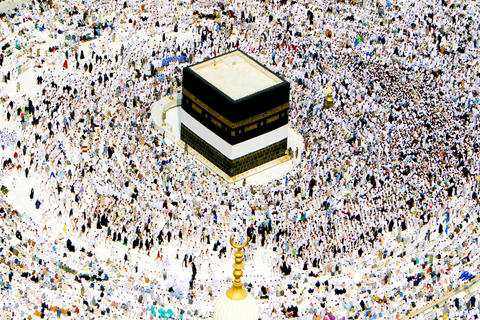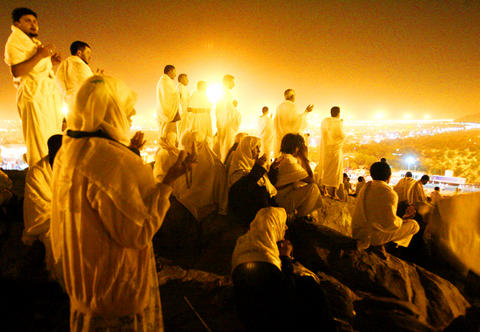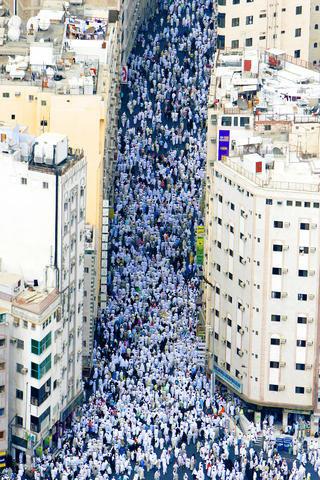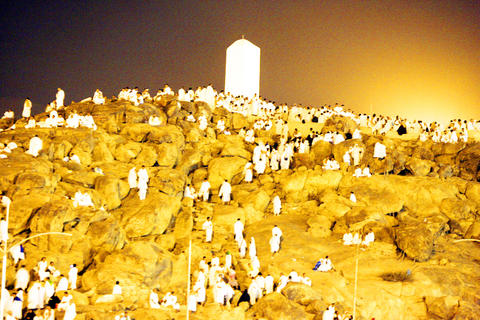P erforming the annual five-day Muslim hajj, more ancient than Islam itself, is complicated and confusing even for those well versed in Islam, so it’s particularly intimidating for someone who’s hardly religious.
As a secular journalist covering the hajj, a central pillar of Islam, which began on Monday, I am determined to go through the rites with an open mind.
A major first hurdle is just learning what to do. Before leaving my hotel in Jeddah for the nearby holy city of Mecca, I took the first required steps. I bathed and put on the special clothes of a woman performing hajj: a white head scarf draping down to my stomach, a long shirt, a pair of loose pants and a white robe down to my ankles.

PHOTOS: AP AND AFP
My colleague, Imad Saeid, coached me through the next step: announcing my intention to perform the pilgrimage. I repeated after him the formula proclaiming the start of my journey, Labeik, Allahuma, labeik (I am here at Your service, Lord, I am here). On Sunday, during the drive through the desert to Mecca — birthplace of Islam’s Prophet Mohammed, about 80km east of Jeddah — the rest of the group gave me a crash course on the rituals, starting with the Kaaba, the black cube-shaped stone shrine that pilgrims circle seven times at the start and end of their hajj.
UNIFIED BY FAITH
Mokhtar Shehada, an Egyptian, wondered if he had to make amends for being aggressive the previous day to a pilgrim who pushed him as he was circling the Kaaba. Hajj rules warn against arguing or fighting during the pilgrimage. Shehada stressed that he had later apologized to the pilgrim.

PHOTOS: AP AND AFP
Our guide from the Saudi Information Ministry, Mansour al-Sibiyani, told Shehada he should check with a cleric about whether he should pay for a goat to be slaughtered and given to the poor, a common penance for mistakes during the rites.
In Mecca, we hit the crowds: Hundreds of thousands of pilgrims massed around the Grand Mosque housing the Kaaba. Saudi officials said Monday some 2.5 million Muslims from around the world are attending this year’s hajj, along with another half million Saudis.
The mass of humanity is an awe-inspiring sight — and that is part of the point. The hajj is a deeply personal rite for the faithful, a chance to get closer to God, walk in the footsteps of Mohammed and Abraham and receive the forgiveness of sins. But it is also a communal experience, a symbol of the unity of the Islamic world.

PHOTOS: AP AND AFP
“It is amazing to see Muslims united, no other activity in the world could bring so many people together for the same purpose, not even a rock band group,” said Eulalle Benichou, a Canadian pilgrim walking with her husband near the Grand Mosque.
Many pilgrims talk of the physical arduousness of hajj as a test of faith. But, as I found, it also makes keeping your mind on faith difficult.
I stopped to perform the noon prayers at the gate of the Grand Mosque, standing shoulder to shoulder with men in the ihram — the required menswear that consists of white pieces of terry cloth, one around the waist, another slung over the shoulder — as well as other women.

PHOTOS: AP AND AFP
But it’s hard to concentrate — not only because I don’t really know how to pray, but also because of the shoving of other pilgrims trying to get to the front of the line.
The layers of white fabric around my head and neck were suffocating and distracting — I don’t normally wear a head scarf — and I looked with envy at the men praying next to me with their bare arms and necks.
Glancing at other worshippers, I tried to follow the prayer movements: standing straight, bowing with hands on the knees, placing the forehead on the floor as in yoga.
As I prostrated myself, the rear end of a man in front of me hit me in the face; later his heels were almost in my mouth.
EQUALITY BEFORE GOD
The close mingling of men and women here is remarkable, when in all other areas of life — particularly in Saudi Arabia — the two genders are strictly segregated. In much of the Arab world, men and women are separated when they pray in mosques, and many conservative men consider it a sin to shake hands with women.
But here in the most sacred place in the Muslim world, men and women pray side by side and touch without the slightest inhibition.
A major theme of the hajj is the equality of all mankind before God — man or woman, rich or poor, young or old.
But it’s not without friction. In the lineup for prayers, a man chastised two women sitting comfortably in front of him for “not giving room to men” to pray.
“It’s not right,” he barked, pointing his finger at the women, who ignored him.
After prayers, we entered the Grand Mosque — stepping with the right foot first as required — to perform the tawaf, the circling of the Kaaba. Inside the giant, multilevel mosque is the mesmerizing sight of a river of people moving around the shrine, as if in a slow ice-skating motion.
The roots of the hajj go back to Abraham, known to Muslims by his Arabic name Ibrahim and considered part of a line of prophets completed by Mohammed in the seventh century. Abraham and his son Ishmael, or Ismail, are believed to have built the Kaaba, the focal point of Muslims around the world when they pray every day.
DISTRACTING SIGHTS
But it was difficult to get into the state of spirituality that many secular friends promised I would arrive at, despite my skepticism and doubts. I was distracted by the pilgrims pushing and shoving — and by the view out of the open-air mosque, with the heavy construction cranes and colorful towers of the five-star hotels around the Kaaba visible.
I tried to pay attention to the rules, laid out in a small booklet provided by pilgrims, but kept forgetting things like raising my hands to the sacred black stone at one corner of the Kaaba at each circuit as all pilgrims do.
In the mosque’s halls surrounding the Kaaba, many pilgrims rested, napped, ate or chatted with each other or on cellphones plugged in to charge in sockets on the marble columns above shelves of copies of the Koran.
The next station was the saii, where pilgrims move back and forth seven times — at a slight run — between the hills of Safa and Marwa, now enclosed within the Grand Mosque complex. The rite reenacts the search by Abraham’s wife Hagar for water for her infant son Ishmael in the desert. After her seventh run, the spring known as Zamzam sprang miraculously under Ishmael’s feet.
Over the next days, the mass of pilgrims moved outside Mecca to sites in the nearby desert. On Tuesday, they gathered on the Plain of Arafat to perform the woqouf, standing in the presence of God in a daylong vigil that marks the zenith of the hajj. Afterwards, they migrate to nearby Mina to perform a ritual stoning of the devil.

April 28 to May 4 During the Japanese colonial era, a city’s “first” high school typically served Japanese students, while Taiwanese attended the “second” high school. Only in Taichung was this reversed. That’s because when Taichung First High School opened its doors on May 1, 1915 to serve Taiwanese students who were previously barred from secondary education, it was the only high school in town. Former principal Hideo Azukisawa threatened to quit when the government in 1922 attempted to transfer the “first” designation to a new local high school for Japanese students, leading to this unusual situation. Prior to the Taichung First

The Ministry of Education last month proposed a nationwide ban on mobile devices in schools, aiming to curb concerns over student phone addiction. Under the revised regulation, which will take effect in August, teachers and schools will be required to collect mobile devices — including phones, laptops and wearables devices — for safekeeping during school hours, unless they are being used for educational purposes. For Chang Fong-ching (張鳳琴), the ban will have a positive impact. “It’s a good move,” says the professor in the department of

On April 17, Chinese Nationalist Party (KMT) Chairman Eric Chu (朱立倫) launched a bold campaign to revive and revitalize the KMT base by calling for an impromptu rally at the Taipei prosecutor’s offices to protest recent arrests of KMT recall campaigners over allegations of forgery and fraud involving signatures of dead voters. The protest had no time to apply for permits and was illegal, but that played into the sense of opposition grievance at alleged weaponization of the judiciary by the Democratic Progressive Party (DPP) to “annihilate” the opposition parties. Blamed for faltering recall campaigns and faced with a KMT chair

Article 2 of the Additional Articles of the Constitution of the Republic of China (中華民國憲法增修條文) stipulates that upon a vote of no confidence in the premier, the president can dissolve the legislature within 10 days. If the legislature is dissolved, a new legislative election must be held within 60 days, and the legislators’ terms will then be reckoned from that election. Two weeks ago Taipei Mayor Chiang Wan-an (蔣萬安) of the Chinese Nationalist Party (KMT) proposed that the legislature hold a vote of no confidence in the premier and dare the president to dissolve the legislature. The legislature is currently controlled